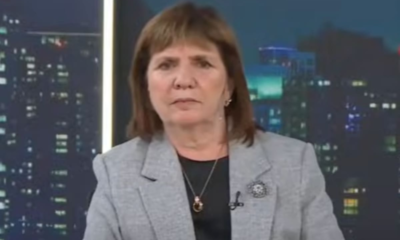INTERNACIONAL
Red state official touts readiness to unleash energy across US: ‘We have our own Greenland’
EXCLUSIVE: Alaska Department of Revenue Commissioner Adam Crum discussed President Trump’s key role in unleashing energy independence in the state while speaking to Fox News Digital and explaining that Alaskan resources are ready to be used if the push to acquire Greenland is unsuccessful.
Crum, speaking to Fox News Digital at the State Financial Officer Foundation conference in Orlando, Florida, explained that the «vast majority» of state government funds in Alaska come from developing natural resources, including mining and crude oil, and praised the Trump administration’s moves to reverse course from the Biden administration when it comes to that development.
«President Trump, you know our Governor Dunleavy has actually said he’s probably one of the best presidents for Alaska,» Crum said. «In his first term he did tremendous things for us and now in his second term, we were the only state that had an executive order directed at us and that was such a crucial thing, and it really improved our economic outlook within the state.»
On the first day of his presidency, Trump signed an executive order advancing the Ambler Access Project, a 211-mile industrial road through the Brooks Range foothills that enables commercial mining of copper, zinc and other materials in a remote Arctic area in Northwest Alaska.
ALASKA SENATOR LITERALLY SHREDS BIDEN’S ENERGY ORDERS, BOOSTS WH EFFORTS TO LEVERAGE ARCTIC GAS PIPELINE
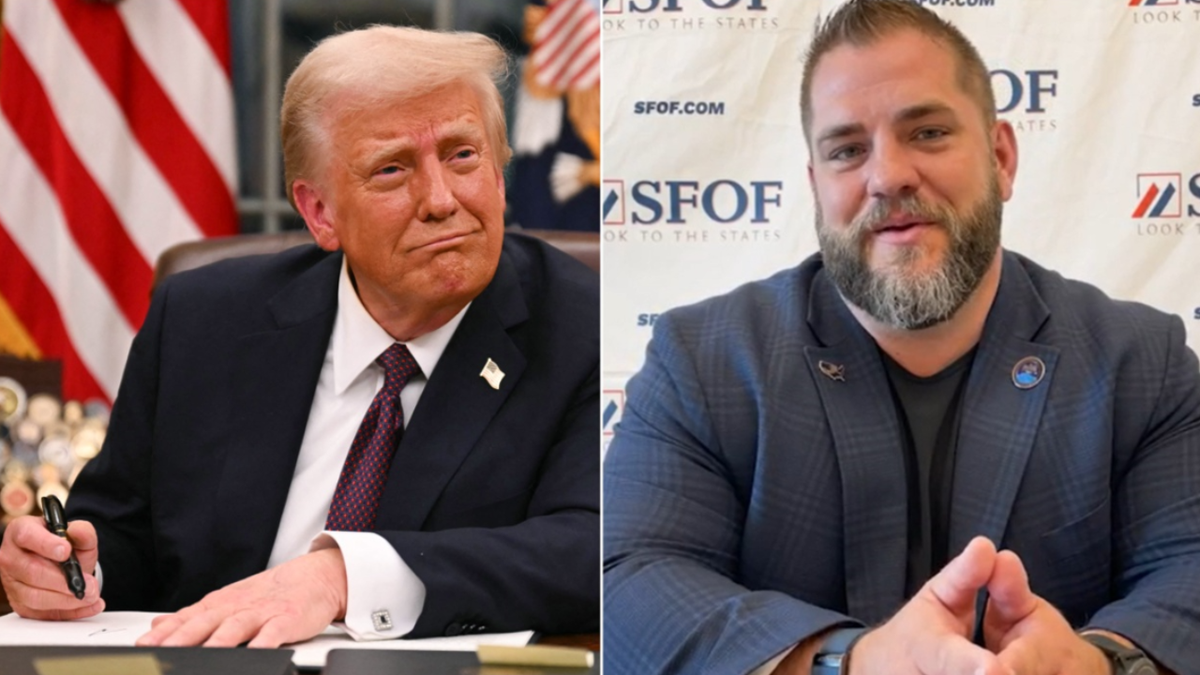
Fox News Digital spoke to Alaska Department of Revenue Commissioner Adam Crum, right, about energy production in his state. (Fox Digital/Getty)
Experts told Fox News Digital in February that the action, which reversed course from the Biden administration, will play a critical role in developing mineral resources in the state.
«We think that we are on the precipice in Alaska on an energy boom, when it comes to large-scale oil development, the natural gas line getting developed that the president really pushes very hard for, as well as all of these critical minerals that we need to get processed,» Crum said.
President Trump has vocally called for the United States to acquire Greenland for strategic purposes as well as due to its natural resources. Crum told Fox News Digital that Alaska is ready to step up when it comes to natural resources.
NORTHERN HIGHLIGHTS: ALASKA’S ENERGY, SECURITY POLICIES ARE THE GUIDE FEDS NEED AMID TRANSITION, GROUP SAYS
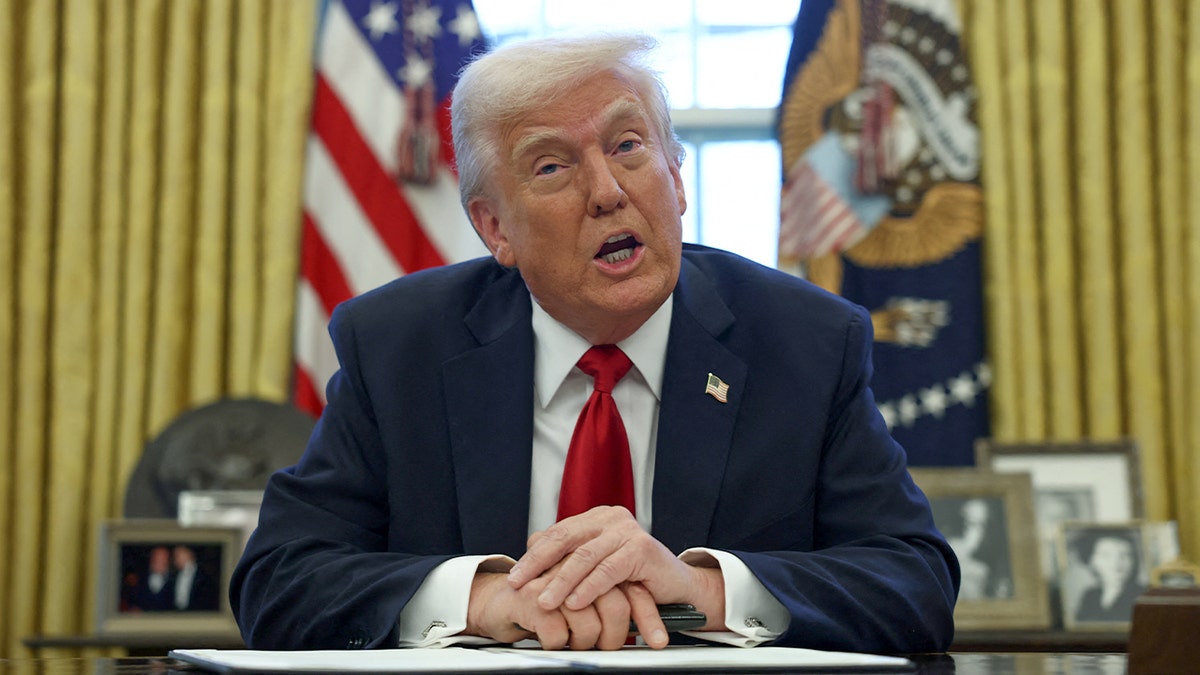
President Donald Trump speaks to the media in the Oval Office at the White House in Washington, D.C. (REUTERS/Evelyn Hockstein)
«We do have our own Greenland. We have our Greenland that has a long history and track record of developing these resources in an area of the world that people would never have thought that it could be done responsibly,» Crum said. «We’ve processed oil for over 60 years on the Arctic Ocean, and we have done so while at the same time building an 800-mile crude oil pipeline that actually has seen the caribou numbers increase over time with that pipeline being built. And so Alaskans are conservationists by nature.»
«We are hunters, we are fishermen, our indigenous population are subsistence, they gather, but we are the ones who use the land. We also want to be able to develop the land, so we make sure we do it the correct way,» Crum continued. «In Alaska, we call it the Alaska standard. We don’t need outside groups telling us that we have to do it responsibly. This is what we demand of companies as they come up there. Come up, be profitable, be clean. Profit Alaska, let Alaskan’s have jobs and opportunities and also go enjoy the outdoors.»
CLICK HERE TO GET THE FOX NEWS APP

Aerial view of oil fields in Arctic National Wildlife Refuge, Prudhoe Bay on March 28. (Simon Bruty)
Ultimately, Crum told Fox News Digital that Alaskan energy independence will not only be good for the United States, but it will also help push back against dependence on countries that have been hostile to the country, including China.
«We also have antimony deposits, which is a rare thing because China is the vast producer and processor of antimony, which is needed for not only technology, but also like munitions and military, and so we’ve got very viable deposits within Alaska on these things,» Crum explained.
Politics,Energy,Alaska,Donald Trump
INTERNACIONAL
Trump says SCOTUS immunity ruling likely helps Obama in light of Gabbard, DNI findings
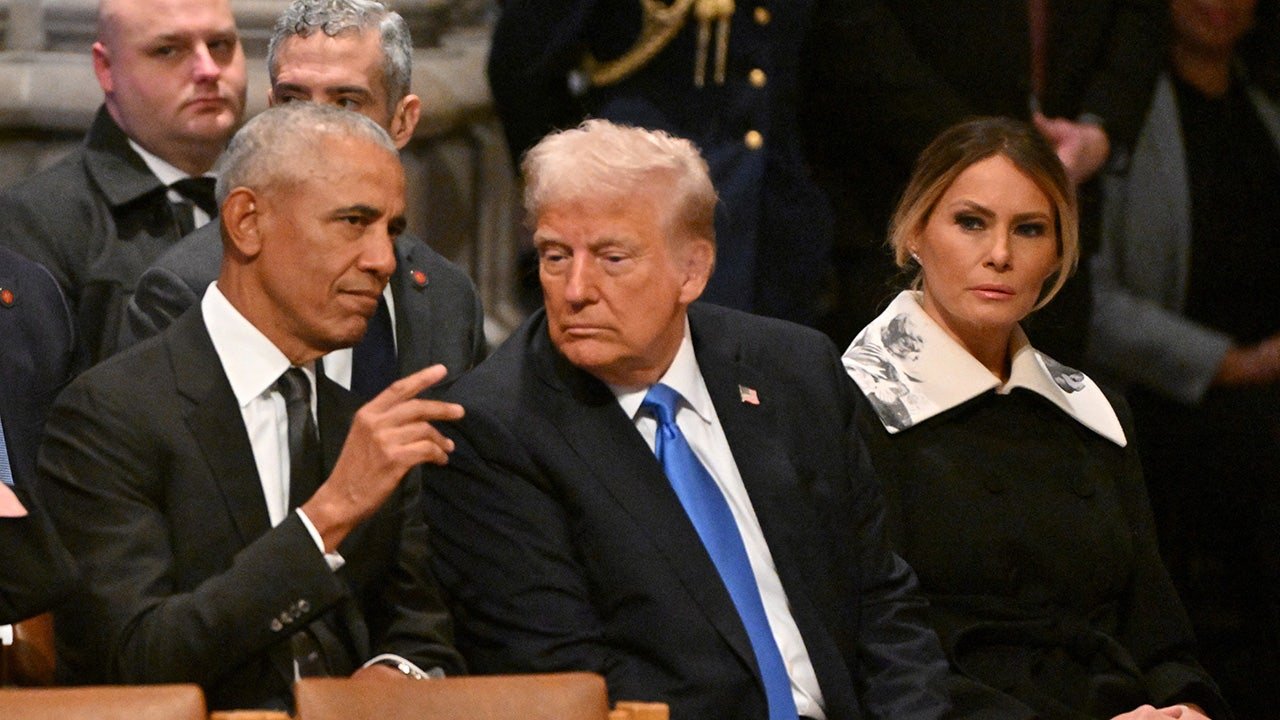
NEWYou can now listen to Fox News articles!
President Donald Trump said Friday that former President Barack Obama «owes me big» following the Supreme Court’s presidential immunity ruling.
Trump on Tuesday claimed that Obama was the «ringleader» of Russiagate, calling for him to be criminally investigated amid new claims that members of his administration allegedly «manufactured» intelligence that prompted the Trump–Russia collusion narrative. Obama has denied the allegations, with a spokesperson for him describing them as «bizarre.»
«It probably helps him a lot. Probably helps a lot. The immunity ruling, but it doesn’t help the people around him at all. But it probably helps him a lot,» Trump said Friday. «He’s done criminal acts, there’s no question about it. But he has immunity, and it probably helps him a lot… he owes me big, Obama owes me big.»
The intelligence community did not have any direct information that Russian President Vladimir Putin wanted to help elect Donald Trump during the 2016 presidential election, but, at the «unusual» direction of then-President Barack Obama, published «potentially biased» or «implausible» intelligence suggesting otherwise, the House Intelligence Committee found, according to a Fox News report earlier this week.
OBAMA DENIES TRUMP’S ‘BIZARRE ALLEGATIONS’ THAT HE WAS RUSSIAGATE ‘RINGLEADER’ IN RARE STATEMENT
Former President Barack Obama speaks with President-elect Donald Trump as they attend the State Funeral Service for former President Jimmy Carter at the Washington National Cathedral in Washington, D.C., on Jan. 9, 2025. (Roberto Schmidt/AFP via Getty Images)
Director of National Intelligence Tulsi Gabbard had declassified a report prepared by the House Permanent Select Committee on Intelligence back in 2020.
The report, which was based on an investigation launched by former House Intelligence Committee Chairman Devin Nunes, R-Calif., was dated Sept. 18, 2020. At the time of the publication of the report, Rep. Adam Schiff, D-Calif., was the chairman of the committee.
The committee focused on the creation of the Intelligence Community Assessment of 2017, in which then-CIA Director John Brennan pushed for the inclusion of the now-discredited anti-Trump dossier, despite knowing it was based largely on «internet rumor,» as Fox News Digital previously reported.
According to the report, the ICA was a «high-profile product ordered by the President, directed by senior IC agency heads, and created by just five CIA analysts, using one principal drafter.»
«Production of the ICA was subject to unusual directives from the President and senior political appointees, and particularly DCIA,» the report states. «The draft was not properly coordinated within CIA or the IC, ensuring it would be published without significant challenges to its conclusions.»
DNI GABBARD CLAIMS ‘DEEP STATE ACTORS’ DIDN’T WANT TRUMP-RUSSIA INFORMATION TO ‘SEE THE LIGHT OF DAY’

Director of National Intelligence Tulsi Gabbard talks to reporters in the Brady Press Briefing Room at the White House on July 23, 2025, in Washington, D.C., after releasing newly-declassified documents about the Trump-Russia collusion ‘hoax.’ ((Chip Somodevilla/Getty Images | Fox News Digital))
The committee found that the five CIA analysts and drafter «rushed» the ICA’s production «in order to publish two weeks before President-elect Trump was sworn-in.»
In a statement Tuesday, Obama denied Trump’s «bizarre allegations» that he was the Russiagate «ringleader.»
«Out of respect for the office of the presidency, our office does not normally dignify the constant nonsense and misinformation flowing out of this White House with a response,» Obama spokesman Patrick Rodenbush said in a statement. «But these claims are outrageous enough to merit one.»
«These bizarre allegations are ridiculous and a weak attempt at distraction,» Obama’s spokesman continued. «Nothing in the document issued last week undercuts the widely accepted conclusion that Russia worked to influence the 2016 presidential election but did not successfully manipulate any votes.»
Gabbard later told «Jesse Watters Primetime» on Wednesday that there were «deep state obstacles» to releasing her information about the Trump-Russia collusion investigation and that some people within the intelligence community (IC) didn’t want it to «see the light of day.»
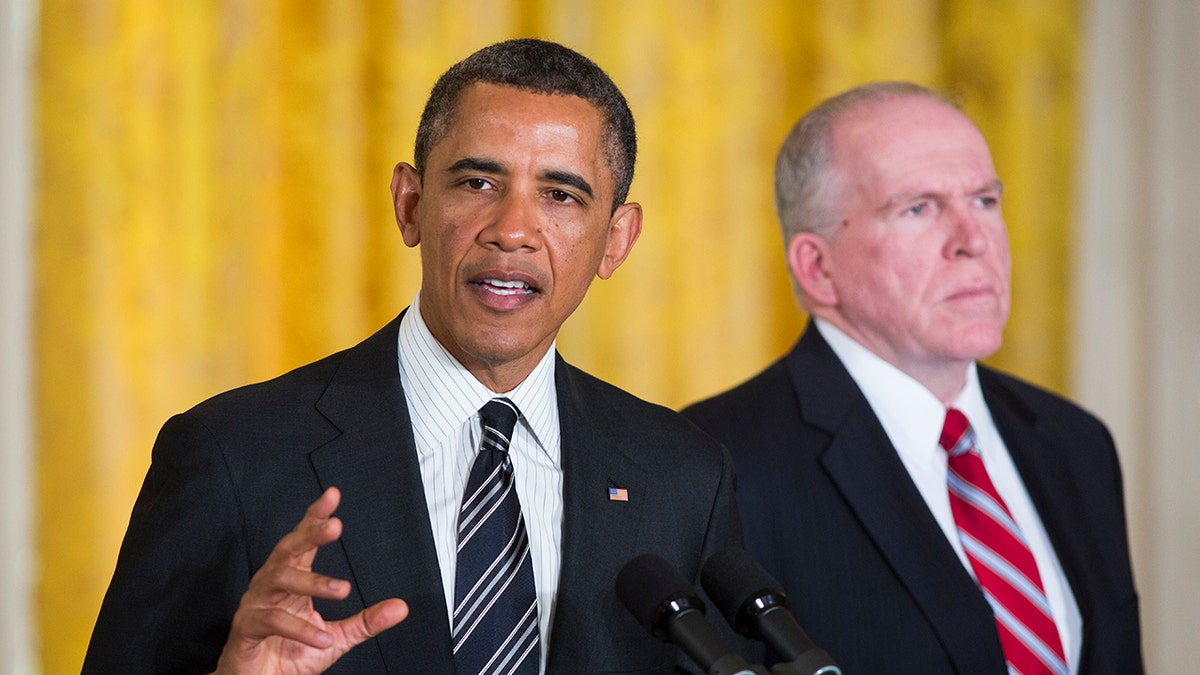
Then-President Barack Obama in the East Room of the White House in Washington, making an announcement nominating John Brennan, right, as the new CIA director. (Brooks Kraft LLC/Corbis via Getty Images)
CLICK HERE TO GET THE FOX NEWS APP
«There are a lot of deep state actors still here within Washington. President Trump wants us to find the truth. I want to find that truth. The American people deserve the truth, and they deserve accountability,» she said.
Fox News’ Brooke Singman and Ashley Carnahan contributed to this report.
INTERNACIONAL
Columbia caminó por la cuerda floja en su camino hacia un acuerdo de 200 millones de dólares con Trump

Justo después del Día de los Caídos, Claire Shipman, presidenta interina de la Universidad de Columbia, visitó a Linda E. McMahon, secretaria de educación del presidente Trump. La institución y la administración Trump se encontraban en un punto muerto por el antisemitismo en el campus, y la mayor parte de los 1.300 millones de dólares en fondos federales para investigación de Columbia estaban en peligro.
Fue una reunión difícil, pero hubo momentos sorprendentemente colaborativos. La Sra. McMahon dijo que no le interesaba destruir la universidad. Empatizó con lo difícil que era dirigir una gran organización. Quería hablar de temas más allá del antisemitismo, como la necesidad de tolerar diversas voces en los campus.
En lugar de desestimar esas preocupaciones de plano, la Sra. Shipman, experiodista y copresidenta del consejo directivo de Columbia antes de asumir la presidencia interina, escuchó.
Fue un momento revelador que contribuyó a los trascendentales acontecimientos del miércoles.
Esa noche, se reveló que Columbia y la administración Trump habían llegado a un acuerdo que permite que cientos de millones de dólares de fondos federales para investigación vuelvan a fluir a Columbia. El acuerdo pone fin a las investigaciones de derechos civiles sobre antisemitismo en la universidad. A cambio, Columbia pagará una multa de 200 millones de dólares al gobierno y 21 millones adicionales para resolver las demandas por discriminación laboral. Un monitor independiente informará al gobierno sobre el cumplimiento del acuerdo por parte de la universidad.

Aunque hubo aspectos en los que no coincidieron, la Sra. Shipman y otros líderes de Columbia coincidieron en gran medida con Washington en que existía un problema de antisemitismo en el campus. Según una encuesta reciente encargada por Columbia, el 62 % de los estudiantes judíos del año pasado afirmaron no sentirse aceptados por su identidad religiosa en la universidad. Algunos consideraban que también existía un problema más amplio de intolerancia, ya que demasiadas personas optaban por excluir, en lugar de interactuar, con otros puntos de vista.
Así pues, la Sra. Shipman buscó lo que llamó las “semillas” de la verdad en los asuntos citados por la Casa Blanca, incluyendo lo que percibía como una ortodoxia académica en el campus o la incapacidad de escuchar otras voces. Ella y otros líderes de Columbia se convencieron de que podían negociar un acuerdo con Trump para abordar los aspectos del campus que, según ellos, estaban rotos, siempre y cuando no traspasaran sus límites ni comprometieran la libertad académica.
El acuerdo fue inmediatamente criticado por muchos, tanto dentro como fuera de Columbia, por considerarlo una cesión ante la administración Trump. La misma táctica de retener fondos para investigación científica para presionar a Columbia por los disturbios en el campus probablemente era ilegal, según dictaminó un juez de Massachusetts. Sin embargo, algunos en el campus, en particular aquellos preocupados por el futuro de la investigación científica, aplaudieron el acuerdo, con la esperanza de que permitiera a Columbia recuperar su estabilidad.
“Entiendo perfectamente el deseo de una narrativa simple: capitulación versus valentía, o hablar versus luchar”, declaró la Sra. Shipman en una entrevista con The New York Times el miércoles. “Miren, como experiodista, me inclino por esos temas. Pero supongo que todos sabemos que las situaciones de la vida real son profundamente complejas. Y realmente diría que proteger nuestros principios, lenta y cuidadosamente mientras estabilizamos la institución, también requiere valentía y está lejos de ser una capitulación”.
Este relato de cómo y por qué Columbia decidió llegar a un acuerdo con la administración Trump en lugar de litigar se basa en entrevistas con seis personas con conocimiento de las negociaciones, la mayoría de las cuales hablaron bajo condición de anonimato para poder hablar de conversaciones privadas.
Columbia ha enfrentado disturbios en el campus desde los ataques de Hamás del 7 de octubre de 2023. El estallido de sentimiento del lado pro-palestino, que aprovechó el momento como una oportunidad para pedir la liberación de Palestina, tomó a muchos por sorpresa. A las pocas semanas de los atentados, mientras los estudiantes judíos e israelíes aún lloraban a sus muertos, estallaron en el campus enfrentamientos a gritos entre estudiantes proisraelíes y propalestinos, acusándose mutuamente de apoyar el genocidio.
El movimiento estudiantil propalestino de Columbia galvanizó el campus, logrando el apoyo de miles de personas. La mayoría de los estudiantes que votaron en referendos no vinculantes apoyaron la desinversión en Israel, cuyas bombas caían sobre Gaza. Sin embargo, algunos estudiantes judíos se sentían cada vez más aislados y asustados. Cánticos como “no queremos sionistas aquí” parecían dirigidos a ellos personalmente.
Minouche Shafik, entonces presidenta de Columbia, no pudo controlar el creciente activismo estudiantil y se negó a llegar a un acuerdo con los manifestantes para desinvertir. Decretó el cierre del campus y llamó al Departamento de Policía dos veces para poner fin a las manifestaciones. Apenas unas semanas antes del inicio del nuevo año académico, en agosto de 2024, dimitió. Aun así, los problemas de Columbia siguieron siendo en gran medida un asunto interno, hasta que el presidente Trump fue elegido.

El 7 de marzo, el gobierno federal canceló o congeló más de 400 millones de dólares en fondos de investigación, argumentando que Columbia ya no cumplía los requisitos para recibir el apoyo debido a su presunta tolerancia al acoso antisemita en el campus. Fue la primera universidad en ser sancionada de esta manera. Harvard, Cornell y Northwestern le siguieron poco después. Un grupo de trabajo sobre antisemitismo que Trump reunió tras llegar a la Casa Blanca emitió una lista de nueve demandas que reflejaban las peticiones de algunos grupos judíos en el campus, solicitando más restricciones a las manifestaciones, mayor supervisión académica y una disciplina más estricta.
La junta directiva de Columbia, compuesta por 21 miembros, en consulta con los abogados de la universidad, decidió negociar. Los abogados informaron a la junta que demandar probablemente traería beneficios a corto plazo, pero que el gobierno aún podría excluir a Columbia de la consideración para futuras subvenciones. Esto generaría una situación extremadamente inestable, que pondría en riesgo miles de millones de dólares de importantes fondos de investigación.
Durante la presidencia interina de Katrina Armstrong, la junta llegó a un acuerdo con el que consideró viable. La universidad modificó cada exigencia de forma que no comprometiera sus valores fundamentales ni la independencia académica.
En lugar de una prohibición total del uso de mascarillas, por ejemplo, se exigiría a los manifestantes enmascarados que mostraran una identificación cuando se les solicitara. En lugar de someter al departamento de Estudios de Oriente Medio a administración judicial, una medida que eliminaría su independencia, un nuevo vicerrector revisaría el trabajo del departamento, junto con el de otros departamentos.
“Si podemos hacer algo que ya teníamos pensado hacer sin tener que litigar y restaurar lo que nos importa aquí, ese es, en nuestra opinión —o en la mía—, el mejor camino”, declaró Keith Goggin, miembro del consejo, en una asamblea pública del senado universitario en primavera. “Y quizá no podamos seguir ese camino, pero ahí estamos hoy”.
La Sra. McMahon, secretaria de educación, afirmó públicamente que Columbia iba por buen camino. Sin embargo, días después, la Dra. Armstrong fue duramente criticada por cómo describió el acuerdo en una reunión privada del profesorado. Una transcripción de la reunión se filtró a los medios, insinuando que estaba minimizando su compromiso con cambios reales. A los pocos días, renunció y la Sra. Shipman la sucedió.
A principios de abril, la Casa Blanca presentó a Columbia los términos de un decreto de consentimiento, un plan de mejora del rendimiento legalmente vinculante que generalmente implica una orden judicial y que dejaría a Columbia bajo supervisión federal durante los próximos años. El plan, mucho más estricto que el acuerdo final, se filtró a la prensa y se presentó como inminente, a pesar de que las negociaciones continuaban.
El 11 de abril, Harvard publicó su propia carta de la Casa Blanca, que exigía aún más a la universidad que recuperara miles de millones de dólares en financiación para la investigación. Sintiendo que su independencia estaba en juego, Harvard declaró que demandaría, no negociaría. De repente Washington tuvo ante sí una situación más urgente y cambió su enfoque.
El tiempo extra ayudó a Columbia a consolidar su estrategia de negociación. A medida que se retiraban miles de millones de dólares de Harvard y se ponía en duda su capacidad para matricular estudiantes internacionales, lo que estaba en juego se hizo evidente. También se hizo evidente internamente en Columbia que el golpe a su iniciativa científica era mucho mayor que los 400 millones de dólares originales.
Columbia ahora afirma que la mayor parte de sus 1300 millones de dólares en subvenciones federales anuales se había congelado o suspendido. También se le prohibió a la universidad competir por nuevas subvenciones. En mayo, cerca de 180 personas fueron despedidas. Cada día, los científicos recibían nuevas ofertas y tenían la incertidumbre de si Columbia seguiría siendo un centro de investigación importante.
El gobierno continuó aumentando la presión, abriendo nuevas investigaciones sobre violaciones de los derechos civiles contra estudiantes judíos en Columbia. A finales de mayo, el gobierno federal declaró a Columbia violando las normas de derechos civiles por “actuar con deliberada indiferencia” ante el acoso a estudiantes judíos. En junio, el Departamento de Educación envió una carta al organismo que otorga a Columbia y otras escuelas un sello vital de aprobación (la acreditación) y advirtió que la universidad podría perder esa credencial vital, clave para recibir ayuda federal para estudiantes.

Todos estos eran problemas muy reales que debían resolverse con el gobierno.
“Pensamos que tenía sentido seguir dialogando mientras se lograran avances”, dijo la Sra. Shipman.
Mantuvo múltiples conversaciones con la Sra. McMahon y miembros de su personal, según una persona con conocimiento de las conversaciones. La Sra. Shipman también habló con abogados de las agencias que integran el grupo de trabajo sobre antisemitismo de la administración Trump, así como con representantes de la Casa Blanca y el Departamento de Justicia.
La Sra. Shipman trabajó con los fideicomisarios y un pequeño equipo académico que reunió. Este incluía a un experto en negociación, quien les indicó que es posible llegar a un acuerdo, incluso con un oponente con el que se tienen profundas diferencias, siempre que se mantengan los principios fundamentales.
El trabajo fue minucioso. “En realidad, es un acto de equilibrio”, dijo la Sra. Shipman, aproximadamente una semana antes de que se anunciara el acuerdo. “Queremos este acuerdo, lo necesitamos. Queremos recuperar una buena relación con el gobierno y volver a ser un socio de investigación. Y, sin embargo, debemos proteger algunos aspectos fundamentales de nuestra identidad como institución”. Se selló un acuerdo.
Pareció producirse un avance en las negociaciones cuando la Casa Blanca propuso multas monetarias para ayudar a resolver las quejas sobre derechos civiles. Las partes también acordaron nombrar a un monitor independiente, a quien elegirían mutuamente. El monitor garantizaría el cumplimiento de los términos del acuerdo.
Columbia adoptó un enfoque práctico respecto a la enorme tarifa del acuerdo. El dinero era menos importante que los valores fundamentales: Columbia consideraba que este acuerdo no dictaría quién enseña, qué enseña ni qué estudiantes son admitidos.
“No se trata de una cantidad de dinero que nos quiebre, pero los valores fundamentales son la clave”, dijo un alto administrador académico de Columbia involucrado en las negociaciones.

A juicio de los negociadores de Columbia, gran parte de lo acordado —el compromiso de respetar las leyes de derechos civiles y no participar en prácticas ilegales de diversidad— habría sido necesario de todos modos bajo la administración Trump. La mayoría de las reformas internas, como la centralización del control disciplinario estudiantil y el nombramiento de al menos 36 agentes de seguridad con facultades de arresto, son cambios a los que ya se habían comprometido.
Para la semana pasada, se estaba cerca de un acuerdo. Un equipo de funcionarios y abogados de Columbia, incluida la Sra. Shipman, se reunió en una sala de recepción diplomática de la Casa Blanca durante una hora con May Mailman, estratega política, y otros funcionarios de Trump para discutir algunos detalles finales.
“El daño a Columbia no fue especulativo. Fue real y real”, declaró Jeh Johnson, copresidente de la junta y secretario de Seguridad Nacional durante la administración Obama.
“Sin una resolución con el gobierno, nos enfrentábamos a la pérdida de nuestra actividad de investigación tal como la conocemos, incluyendo la salida de nuestros mejores científicos y, sin duda, más despidos”, declaró el Sr. Johnson. “Teníamos que detener la hemorragia”.
© The New York Times 2025.
Crime,Asylum / Immigration / Refugees,North America,NEW YORK
INTERNACIONAL
Una exposición de manuscritos de hace 1.300 años muestra que los monjes no se limitaban a copiar: en los márgenes hay bromas, ironías y quejas

Unos manuscritos medievales de 1.300 años, repletos de garabatos y anotaciones inesperadamente humanas, han salido a la luz en una exposición que desafía la imagen solemne de la vida monástica irlandesa. El Museo Nacional de Irlanda, en Kildare Street, Dublín, presenta hasta el 24 de octubre una muestra que revela cómo los monjes del siglo IX no solo copiaban textos sagrados, sino que también dejaban constancia de sus frustraciones, bromas y temores cotidianos.
Según informó Fox News, estos documentos, junto con más de un centenar de objetos históricos, ofrecen una ventana inédita a la vida y personalidad de los monjes irlandeses, mostrando que la espiritualidad medieval también tenía espacio para la queja, el humor y la preocupación por las amenazas externas.
La exhibición, titulada “Words on the Wave: Ireland and St. Gallen in Early Medieval Europe“, reúne más de 100 piezas de alto valor histórico y cultural, muchas de las cuales se muestran al público por primera vez. El acceso es gratuito, lo que facilita que tanto especialistas como curiosos puedan acercarse a este periodo fundamental de la historia irlandesa. De acuerdo con el reporte de Fox News, la muestra incluye diecisiete manuscritos antiguos cedidos en préstamo por la Biblioteca de la Abadía de San Galo, en Suiza, una de las instituciones monásticas más antiguas de Europa.
Entre los libros expuestos destaca el “Institutiones Grammaticae” de Prisciano, un tratado gramatical del siglo VI que, siglos después de su redacción, se convirtió en el lienzo improvisado de los monjes irlandeses. Según detalló el National Museum of Ireland en declaraciones recogidas por Fox News, este volumen contiene “miles de garabatos en los márgenes escritos en irlandés antiguo”, lo que lo convierte en un testimonio excepcional de la vida intelectual y emocional de sus copistas.

Aunque los manuscritos se conservan hoy en la Abadía de San Galo, su origen se remonta a los monasterios de Nendrum o Bangor, en el norte de Irlanda. Estiman que los monjes irlandeses realizaron estas anotaciones en la década de 850, antes de que los libros viajaran al continente europeo, donde se integraron en la biblioteca suiza en menos de una década.
El “Institutiones Grammaticae” no solo es valioso por su contenido gramatical, sino también por las voces que emergen de sus márgenes. Estos garabatos permiten a los visitantes acercarse a una dimensión poco explorada de la historia monástica.

Lejos de limitarse a copiar textos sagrados, los monjes irlandeses del siglo IX aprovecharon los márgenes de los manuscritos para expresar sus pensamientos más mundanos. Entre los ejemplos más llamativos, recogidos por Fox News y The Guardian, figura la confesión de un monje que escribió estar “ale-killed“, una expresión que indica que sufría una resaca. Esta anotación, traducida como “muerto por la cerveza”, rompe con la imagen de austeridad y recogimiento que suele asociarse a la vida monástica.
Otras anotaciones reflejan las dificultades materiales y climáticas que enfrentaban los copistas. Uno de los garabatos más citados reza: “Nuevo pergamino, mala tinta. Oh, no digo nada más“, una queja que pone de manifiesto los problemas cotidianos de quienes trabajaban en la producción de libros. Además, los monjes no ocultaban sus temores ante las amenazas externas. En una de las entradas, un fraile expresa su preocupación por las incursiones vikingas: “Amarga es la noche, el viento agita el cabello blanco del océano: no temo el curso del mar claro por los fieros héroes de Lothlend”.
El curador Matthew Seaver, en declaraciones recogidas por The Guardian y citadas por Fox News, subrayó el valor de estos textos: “Ofrecen una visión poco común y muy real de la vida cotidiana de los monjes irlandeses medievales”. Seaver añadió que los manuscritos están “llenos de voces humanas, humor, frustración y resiliencia”, lo que permite comprender mejor la complejidad emocional y social de los religiosos de la época.

Para Matthew Seaver, curador del National Museum of Ireland, la importancia de estos manuscritos radica en su capacidad para humanizar a los monjes medievales. Según explicó en declaraciones recogidas por Fox News, los garabatos y anotaciones “ofrecen una visión rara y muy real de la vida diaria y las personalidades de los monjes irlandeses medievales”.
Seaver destacó que estos textos están “llenos de voces humanas, humor, frustración y resiliencia”, lo que permite a los visitantes conectar con los sentimientos y preocupaciones de quienes vivieron hace más de un milenio. El curador también señaló que, aunque muchas de las bromas y juegos de palabras requieren conocimientos de irlandés antiguo para ser comprendidos en su totalidad, la esencia de las emociones y situaciones descritas resulta universal.
La exposición, según Seaver, invita a repensar la imagen tradicional de los monjes como figuras exclusivamente espirituales y a reconocer su humanidad en toda su complejidad.

La muestra no se limita a los manuscritos. Entre los objetos más destacados figuran un broche del siglo VIII, una espada vikinga y el relicario de libros más antiguo y grande de Irlanda, conocido como el Lough Kinale Book Shrine. Estos artefactos, según detalló Fox News, complementan la narrativa de la exposición al ilustrar la riqueza material y simbólica de la Irlanda medieval.
El broche celta, ejemplo de la orfebrería de la época, y la espada vikinga, testimonio de los contactos y conflictos con los pueblos nórdicos, permiten contextualizar las preocupaciones expresadas en los manuscritos. El relicario de libros, por su parte, subraya la importancia que los monjes otorgaban a la conservación y protección de los textos sagrados y literarios.

El presidente del Museo Nacional de Irlanda, Cathal O’Donoghue, destacó la relevancia de la exposición en una declaración recogida por Fox News. O’Donoghue afirmó sentirse “honrado de recibir este préstamo significativo” y calificó la muestra como “la exhibición más significativa en décadas” para la institución de Kildare Street. Según él, la presentación de los manuscritos proporciona “un contexto único para la exhibición de artefactos de nuestra propia colección, muchos de los cuales han sido recientemente conservados y se muestran al público por primera vez”.
La exhibición “Words on the Wave: Ireland and St. Gallen in Early Medieval Europe” permanecerá abierta hasta el 24 de octubre en el National Museum of Ireland, ofreciendo a los visitantes la posibilidad de descubrir, a través de manuscritos y objetos, el lado más humano y cotidiano de los monjes irlandeses medievales.

 ECONOMIA3 días ago
ECONOMIA3 días agoEl consumo en Argentina crece 4% en junio, ante menor inflación y más crédito

 POLITICA2 días ago
POLITICA2 días agoMáximo Kirchner declaró una fortuna de 8.300 millones de pesos: representa un 76% más que el año anterior

 POLITICA22 horas ago
POLITICA22 horas agoLa justicia de Santa Cruz desafío a la Corte Suprema e incluyó a Cristina Kirchner en el padrón electoral















